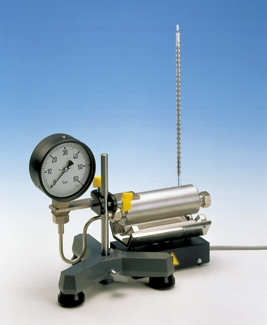Principle
The high-pressure steam apparatus makes it possible to measure steam pressure in a temperature range of 100-250 °C. This allows for investigations to be performed on real gases and vapours. Typical equilibrium states between gas and liquid phases can be set up. For this purpose, water is heated in a closed pressure chamber at constant volume. The heat of vaporisation is determined at various temperatures from the measurement of vapour pressure as a function of temperature.
Benefits
- No open flame in the setup - Reduction of thermal hazard
- No gas burner required - Easy to operate and no consumption of consumables
- compact, easily transportable experimental setup
Tasks
- Measure the vapour pressure of water as a function of temperature.
- Calculate the heat of vaporisation at various temperatures from the values measured.
- Determine boiling point at normal pressure by extrapolation.
Learning objectives
- Boiling point
- Heat of vaporisation
- Clausius-Clapeyron equation
- Van't Hoff law
- Carnot cycle
